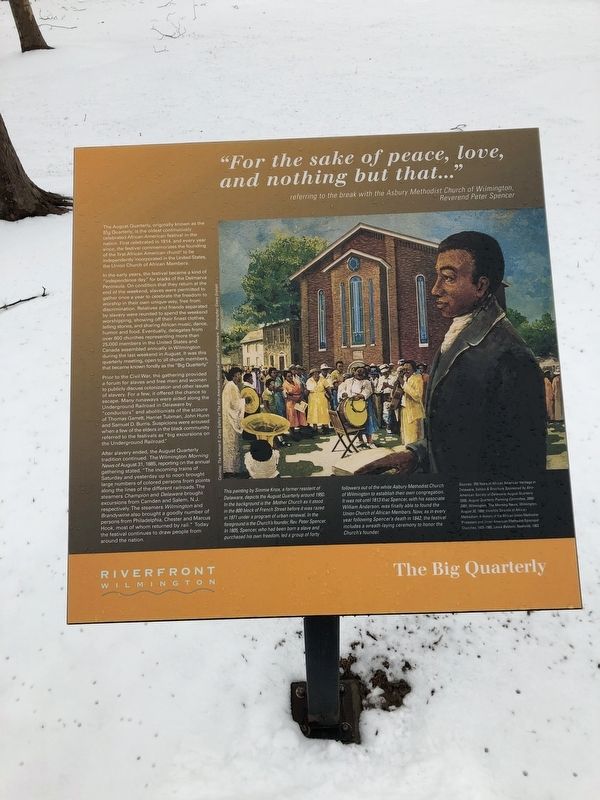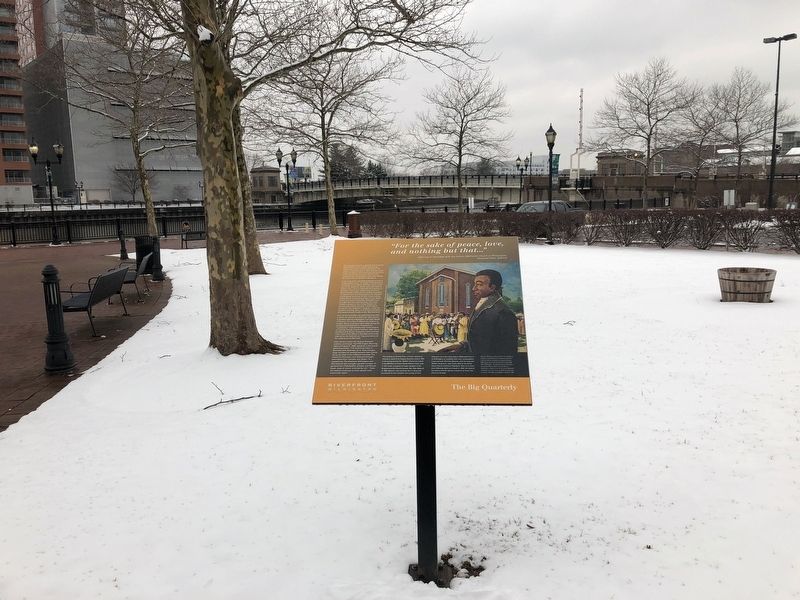Riverfront in Wilmington in New Castle County, Delaware — The American Northeast (Mid-Atlantic)
The Big Quarterly
Riverfront Wilmington
"For the sake of peace, love, and nothing but that..."
referring to the break with the Asbury Methodist Church of Wilmington,
Reverend Peter Spencer
The August Quarterly, originally known as the Big Quarterly, is the oldest continuously celebrated African American festival in the nation. First celebrated in 1814, and every year since, the festival commemorates the founding of the first African American church to be independently incorporated in the United States, the Union Church of African Members.
In the early years, the festival became a kind of "independence day" for blacks of the Delmarva Peninsula. On condition that they return at the end of the weekend, slaves were permitted to gather once a year to celebrate the freedom to worship in their own unique way, free from discrimination. Relatives and friends separated by slavery were reunited to spend the weekend worshipping, showing off their finest clothes, telling stories, and sharing African music, dance, humor and food. Eventually delegates from over 600 churches representing more than 25,000 members in the United States and Canada assembled annually in Wilmington during the last weekend in August. It was this quarterly meeting, open to all church members, that became known fondly as the "Big Quarterly."
Prior to the Civil War, the gathering provided a forum for slaves and free men and women to publicly discuss colonization and other issues of slavery. For a few, it offered the chance to escape. Many runaways were aided along the Underground Railroad in Delaware by "conductors" and abolitionists of the stature of Thomas Garrett, Harriet Tubman, John Hunn and Samuel D. Burris. Suspicions were aroused when a few of the elders in the black community referred to the festivals as "big excursions on the Underground Railroad."
After slavery ended, the August Quarterly tradition continued. The Wilmington Morning News of August 31, 1885, reporting on the annual gathering stated, "The incoming trains of Saturday and yesterday up to noon brought large numbers of colored persons from points along the lines of the different railroads. The steamers Champion and Delaware brought excursions from Camden and Salem, N.J. respectively. The steamers Wilmington and Brandywine also brought a goodly number of persons from Philadelphia, Chester and Marcus Hook, most of whom returned by rail." Today the festival continues to draw people from around the nation.
(Caption)
This painting by Simmie Knox, a former resident of Delaware, depicts the August Quarterly around 1950. In the background is the Mother Church as it stood in the 800 block of French
Erected by Riverfront Wilmington.
Topics. This historical marker is listed in these topic lists: Abolition & Underground RR • African Americans • Churches & Religion. A significant historical month for this entry is August 1814.
Location. 39° 44.204′ N, 75° 33.168′ W. Marker is in Wilmington, Delaware, in New Castle County. It is in Riverfront. Marker is on Rosa Parks Drive east of South Market Street (Business U.S. 13), on the right when traveling east. Touch for map. Marker is at or near this postal address: 80 Rosa Parks Drive, Wilmington DE 19801, United States of America. Touch for directions.
Other nearby markers. At least 8 other markers are within walking distance of this marker. The Great Railroad Boom (here, next to this marker); Thomas Garrett (a few steps from this marker); Harriet Tubman (a few steps from this marker); The Underground Railroad (within shouting distance of this marker); The Tubman-Garrett Riverfront Park (within shouting distance of this marker); South Market Street Bridge Dedicated in Honor of Senator John E. Reilly, Sr. (about 300 feet away, measured in a direct line); Freedom Lost (about 300 feet away); a different marker also named The Great Railroad Boom (about 300 feet away). Touch for a list and map of all markers in Wilmington.
Credits. This page was last revised on February 10, 2023. It was originally submitted on March 2, 2019, by Devry Becker Jones of Washington, District of Columbia. This page has been viewed 274 times since then and 24 times this year. Photos: 1, 2. submitted on March 2, 2019, by Devry Becker Jones of Washington, District of Columbia. • Bill Pfingsten was the editor who published this page.

